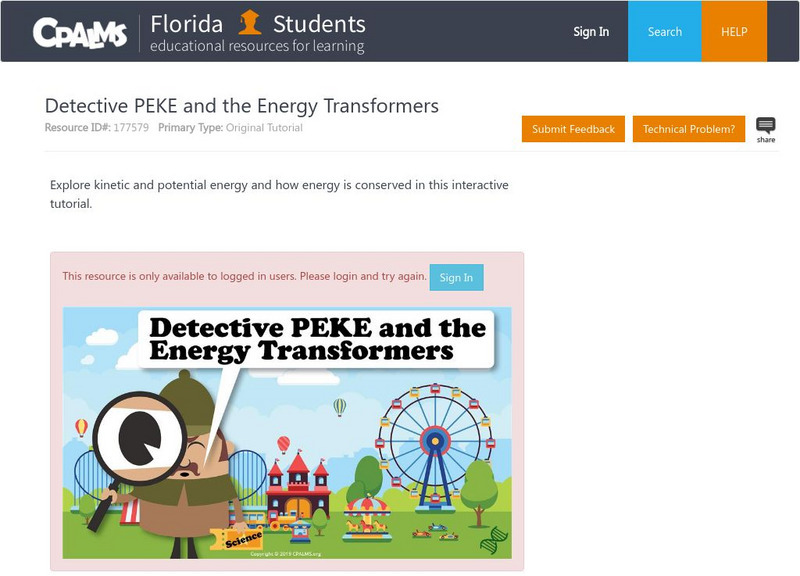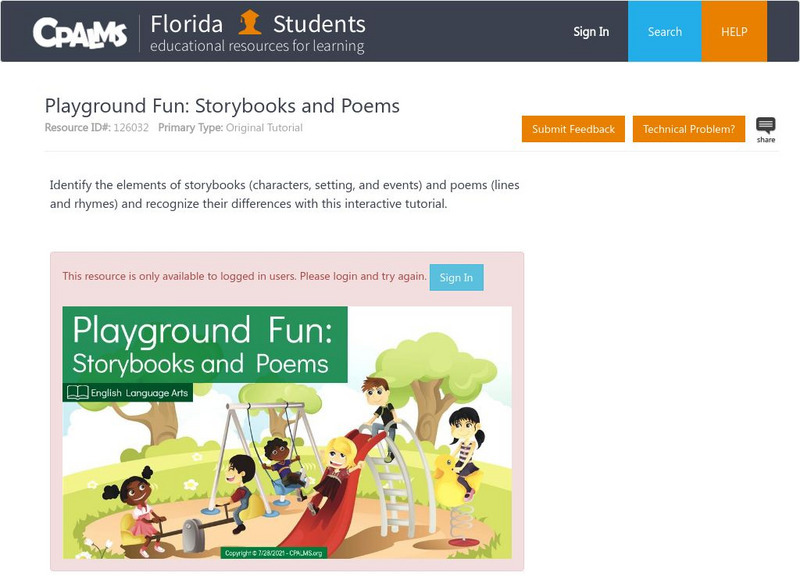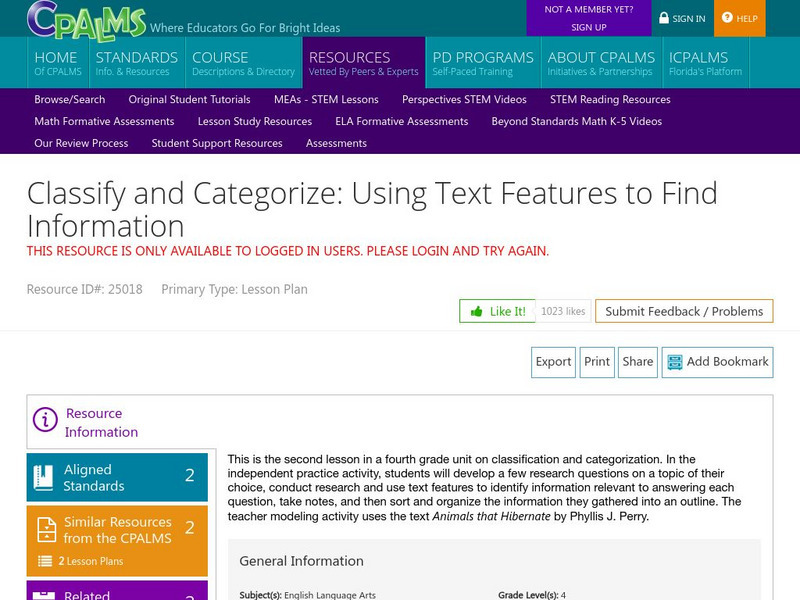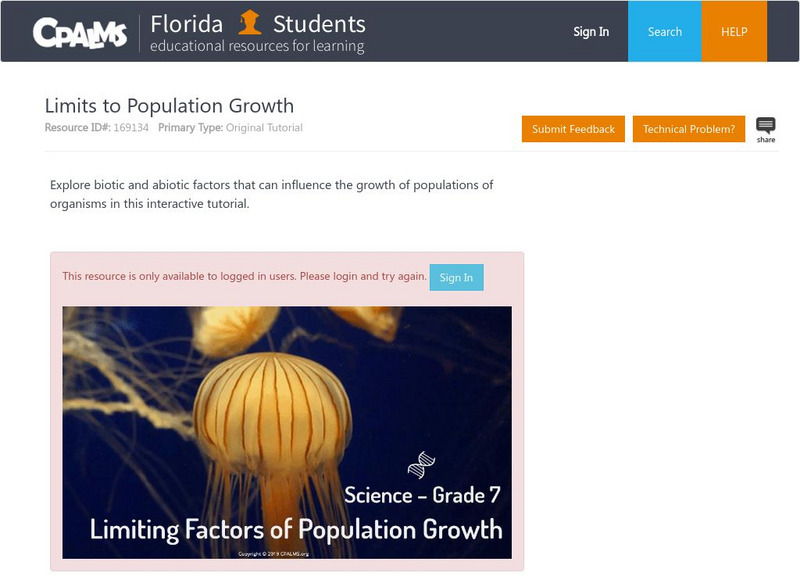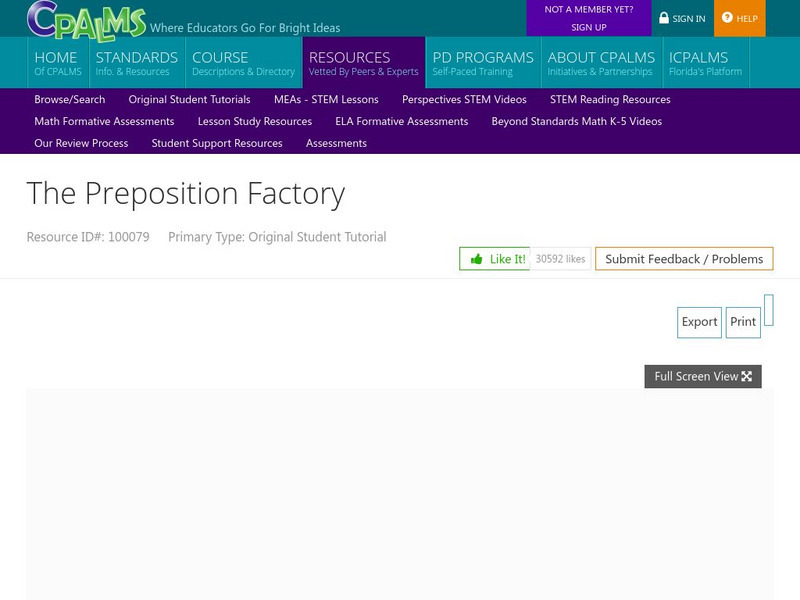CPALMS
Florida State University Cpalms: Florida Students: Scientific Knowledge Changes
A slideshow tutorial will explain how scientific knowledge can change when new evidence is discovered or new ideas are developed. Take a step back in science history to see some great examples of how scientific knowledge has changed when...
CPALMS
Florida State University Cpalms: Florida Students: Plant Organs
Learn the concepts and skills from Grades 9-12 Biology to relate the structure of each of the major plant organs and tissues to physiological processes. Enhance familiarity with the structure, function, and evolutionary origins of plant...
CPALMS
Florida State University Cpalms: Florida Students: Brain Basics
The brain isn't just one big blob sitting in the head, it's actually divided into many distinct parts. Know the names of the major regions of the brain and identify them on a diagram.
CPALMS
Florida State University Cpalms: Florida Students: What Makes Your Blood Flow?
What can contribute to the way blood flows through the body? Find out in this tutorial.
CPALMS
Florida State University Cpalms: Florida Students: Conservation of Mass and Energy in Living Systems
Learn about the conservation of mass and energy as it applies to different living systems.
CPALMS
Florida State University Cpalms: Florida Students: Earth's Spheres
Check out the tutorial which introduces the Earth's spheres. Viewers should be able to identify the Geosphere, Biosphere, Atmosphere, Hydrosphere and Cryosphere and know their differences and similarities.
CPALMS
Cpalms: Reading With Our Eyes, Fingers, Toes, Ears and Nose
[Free Registration/Login Required] For this lesson, young scholars are learning to identify sensory words in their reading, specifically in poetry. Students will gain a perspective on how authors use sensory words to portray their ideas....
CPALMS
Florida State University Cpalms: Florida Students: Classifying & Comparing Physical Properties
Explore and compare physical properties of substances.
CPALMS
Cpalms: Inherited and Learned Behaviors
View this slideshow containing vibrant pictures, examples, and easy to understand text to learn the difference between inherited and acquired traits.
CPALMS
Cpalms: Energy and Cellular Respiration
Learn how food is broken down to produce energy for cells in the in the form of ATP in this interactive tutorial.
CPALMS
Florida State University Cpalms: Florida Students: Detective Peke and the Energy Transformers
Explore kinetic and potential energy and how energy is conserved in this interactive tutorial.
CPALMS
Florida State University Cpalms: Florida Students: Conservation of Mass Tutorial
Learn how mass is conserved in physical and chemical changes.
CPALMS
Florida State University Cpalms: Florida Students: Playground Fun: Storybooks and Poems
Students will learn to recognize storybooks and poems and identify their differences with this interactive tutorial.
CPALMS
Cpalms: Lafs.1112.rst.1.3: Follow Precisely a Complex Multistep Procedure
Find a collection of standards-aligned teacher and student resources where students follow procedural text.
CPALMS
Cpalms: Classify and Categorize: Using Text Features to Find Information
[Free Registration/Login Required] Students will develop research questions, classify information into an outline form, and use the features of nonfiction writing to identify information relevant to a research question.
CPALMS
Cpalms: Name That Embryo
In this lesson plan, students will look at images of embryos from different organisms and identify similarities and differences between them to indicate possible evolutionary relationships. Includes PowerPoint and student handouts.
CPALMS
Cpalms: "Beary" Good Details
This tutorial shares the story of "Goldilocks and the Three Bears" as he goes on a bear hunt to find out who has been sneaking into his house. Question words are highlighted to help Baby Bear collect key details to help him solve this...
CPALMS
Cpalms: Buzzing Tails
This video tutorial features the character named Bobby who will assist students as they search for key details in a nonfiction text.
CPALMS
Florida State University Cpalms: Florida Students: Limits to Population Growth
Explore biotic and abiotic factors that can influence the growth of populations of organisms in this interactive tutorial.
CPALMS
Cpalms: It's All in the Details
Using this comprehensive lesson plan, students will use a web graphic organizer to learn to record the main idea and details learned from informational text read aloud to them.
CPALMS
Cpalms: The Preposition Factory
This interactive lesson requires students to help builders with developing clear and descriptive sentences. Students will learn about nouns, verbs, and prepositions. Students must click on sight words and pictures that answer prompts...
CPALMS
Cpalms: Capitalization Invasion
This video tutorial features outer space missions. Students will learn about capitalizing the first word in every sentence. Students will also learn about the importance of capitalizing the pronoun "I" in sentences.
CPALMS
Cpalms: Lafs.1.ri.4.10
This website offers various resources to meet the common core standard of reading informational texts appropriately complex for grade 1. Resources include center activities, lesson plans, and a professional development article.
CPALMS
Cpalms: Product of Non Zero Rational and Irrational Numbers
[Free Registration/Login Required] In this formative assessment task, students are asked to explain how rational and irrational numbers differ and why the product of a non-zero rational number and an irrational number is irrational....












